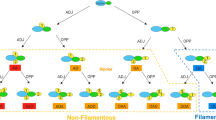Abstract
In contrast toSaccharomyces cerevisiae, nitrogen starvation inhibited formation of hyphae in liquid cultures ofY. lipolytica, while carbon source did not seem to be important for filament formation. Inhibitors of mitochondrial respiration strongly suppressed the development of hyphae, indicating that energy conversion processes, and thus carbon metabolism, may be involved. pH of the medium also strongly affected the morphology, but only in the presence of a complex nitrogen source, implying that the cells respond to altered nutrition in media with different pH rather than to pH itself. The results suggest that theXPR2 gene encodingY. lipolytica alkaline extracellular proteinase is involved in the regulation of dimorphism in this species.
Similar content being viewed by others
References
Barlow A.J.E., Chattaway F.W.: Factors influencing the growth ofCandida albicans in tissue fluids, pp. 49–50 in5th Internat. Congr. Human and Animal Mycology. Compt. Rend. Commun. Pasteur Inst., Paris 1971.
Barth G., Gaillardin C.:Yarrowia lipolytica, inNonconventional Yeasts in Biotechnology. A Handbook (K. Wolf, Ed.). Springer Verlag, Berlin 1996.
Bartnicki-Garcia S., Nickerson W.J.: Nutrition, growth, and morphogenesis ofMucor rouxii.J. Bacteriol.84, 841–858 (1962a).
Bartnicki-Garcia S., Nickerson W.J.: Induction of yeast-like development inMucor by carbon dioxide.J. Bacteriol.84, 829–840 (1962b).
Büschges R., Bahrenberg G., Zimmermann M., Wolf K.: NADH:ubiquinone oxidoreductase in obligate aerobic yeasts.Yeast10, 475–479 (1994).
Clark-Walker S.: Relationship between dimorphism and respiration inMucor genevensis studied with chloramphenicol.J. Bacteriol.116, 972–980 (1973).
Cutler J.E.: Putative virulence factors ofCandida albicans.Ann. Rev. Microbiol.45, 187–218 (1991).
Enderlin C.S., Ogrydziak D.M.: Cloning, nucleotide sequence and functions ofXPR6, which codes for a dibasic processing endoprotease from the yeastYarrowia lipolytica.Yeast10, 67–79 (1994).
Evans E.G., Odds F.C., Richardson M.D., Holland K.T.: Optimum conditions for initiation of filamentation inCandida albicans.Can. J. Microbiol.21, 338–342 (1975).
Friedenthal M., Epstein A., Passeron S.: Effect of potassium cyanide, glucose and anaerobiosis on morphogenesis ofMucor rouxii.J. Gen. Microbiol.82, 15–24 (1974).
Gimeno C.J., Ljungdahl P.O., Styles C.A., Fink G.R.: Unipolar cell divisions in the yeastS. cerevisiae lead to filamentous growth: regulation by starvation and RAS.Cell68, 1077–1090 (1992).
Gold S., Duncan G., Barrett K., Kronstad J.: cAMP regulates morphogenesis in the fungal pathogenUstilago maydis.Genes Dev.8, 2805–2816 (1994).
Lambrechts M.G., Bauer F.F., Marmur J., Pretorius I.S.: Muc1, a mucin-like protein that is regulated by Mss10, is critical for pseudohyphal differentiation in yeast.Proc. Nat. Acad. Sci. USA93, 8419–8424 (1996).
Land G.A., McDonald W.C., Stjernholm R.L., Friedman L.: Factors affecting filamentation inCandida albicans: changes in respiratory activity ofCandida albicans during filamentation.Infect. Immun.12, 119–127 (1975).
Lo H.-J., Köhler J.R., DiDomenico B., Loebenberg D., Cacciapuoti A., Fink G.R.: NonfilamentousC. albicans mutants are avirulent.Cell90, 939–949 (1997).
Madhani H.D., Styles C.A., Fink G.R.: MAP kinases with distinct inhibitory functions impart signalling specificity during yeast differentiation.Cell91, 673–684 (1997).
Mardon D., Balish E., Philips W.: Control of dimorphism in a biochemical variant ofCandida albicans.J. Bacteriol.100, 701–707 (1969).
Medoff G., Painter A., Kobayashi G.S.: Mycelial- to yeast-phase transitions of the dimorphic fungiBlastomyces dermatitidis andParacoccioides brasiliensis.J. Bacteriol.169, 4055–4060 (1987).
Nuttley W.M., Brade A.M., Eitzen G.A., Veenhuis M., Aitchison J.D., Szilard R.K., Glover J.R., Rachubinski R.A.:PAY4, a gene required for peroxisome assembly in the yeastYarrowia lipolytica, encodes a novel member of a family of putative ATPases.J. Biol. Chem.269, 556–566 (1994).
Orlowski M.:Mucor dimorphism.Microbiol. Rev.55, 234–258 (1991).
Pertuiset B., Beckerich J.M., Gaillardin C.: Molecular cloning of Rab-related genes in the yeastYarrowia lipolytica. Analysis ofRYL1, an essential gene encoding aSEC4 homologue.Curr. Genet.27, 123–130 (1995).
Terenzi H.F., Storck R.: Stimulation of fermentation and yeast-like mophogenesis inMucor rouxii by phenethyl alcohol.J. Bacteriol.97, 1248–1261 (1969).
Torres-Guzmán J.C., Domínguez A.:HOY1, a homeo gene required for hyphal formation inYarrowia lipolytica.Mol. Cell. Biol.17, 6283–6293 (1997).
Umbrett W.W., Burris R.H., Stauffer J.F.:Manometric Techniques. Burges Publishing Co., Minneapolis 1957.
Xuan J.-W., Fournier P., Gaillardin C.: Cloning of theLYSS gene encoding saccharopine dehydrogenase from the yeastYarrowia lipolytica by target integration.Curr. Genet.14, 15–21 (1988).
Author information
Authors and Affiliations
Corresponding author
Rights and permissions
About this article
Cite this article
Szabo, R. Dimorphism inYarrowia lipolytica: Filament formation is suppressed by nitrogen starvation and inhibition of respiration. Folia Microbiol 44, 19–24 (1999). https://doi.org/10.1007/BF02816215
Received:
Revised:
Issue Date:
DOI: https://doi.org/10.1007/BF02816215




